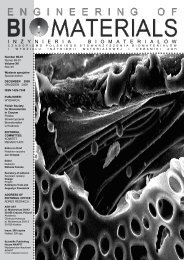69-72 - Polskie Stowarzyszenie BiomateriaÅów
69-72 - Polskie Stowarzyszenie BiomateriaÅów
69-72 - Polskie Stowarzyszenie BiomateriaÅów
Create successful ePaper yourself
Turn your PDF publications into a flip-book with our unique Google optimized e-Paper software.
Materiały i metody<br />
43<br />
PBT-DLA<br />
Multiblokowe kopolimery PBT-DLA i PET-DLA otrzymano<br />
metodą polikondensacji ze stopu [2]. W obydwu materiałach,<br />
udział wagowy segmentów sztywnych (tworzących fazę<br />
twardą) do segmentów giętkich (tworzących fazę miękką)<br />
wynosił 26:74.<br />
Próbki były napromieniowane w temperaturze otoczenia<br />
strumieniem wysokoenergetycznych elektronów generowanych<br />
w liniowym akceleratorze elektronów Elektronika 10/10<br />
do wskazanych dawek. Kopolimer badany metodą EPR<br />
poddano ekspozycji na działanie promieniowania gamma<br />
w źródle 60 Co o mocy dawki 1,2kGy/h.<br />
Widma EPR mierzono z wykorzystaniem spektrometru<br />
Bruker ESP 300 z wnęką prostokątną TE 102.<br />
Lepkość pozorną wyznaczano w wiskozymetrze<br />
Brookfield’a CAP 2000+H w temperaturach podanych na<br />
rysunkach.<br />
Wydajność radiacyjna wodoru G(H 2 ) oraz zużycie tlenu z<br />
przestrzeni wypełniającej naczyńko z próbką G(-O 2 ) oznaczono<br />
stosując chromatograf gazowy Shimadzu-14B. Detekcję<br />
gazów przeprowadzono metodą termokonduktometryczną.<br />
Wyniki i dyskusja<br />
Struktura PBT-DLA i PET-DLA determinuje przebieg<br />
procesów rodnikowych indukowanych promieniowaniem<br />
jonizującym. Udział pierścieni aromatycznych w PBT-DLA<br />
jest mniejszy niż w homopolimerze PBT, zatem rozpraszanie<br />
Próbka<br />
Sample<br />
G(-H 2 )<br />
[µmol/J]<br />
G(-O 2 )<br />
[mmol/J]<br />
PET-DLA 26%/74% 0,066 0,109<br />
PBT-DLA 26%/74% 0,074 0,101<br />
TABELA 1. Wydajność radiacyjna emisji wodoru<br />
i zużycia tlenu.<br />
TABLE 1. Radiation yield of hydrogen emission<br />
and oxygen uptake.<br />
PET-DLA<br />
Samples of copolymers were irradiated at ambient temperature<br />
with a high energy electron beam generated in<br />
a linear electron accelerator Elektronika 10/10 to indicated doses.<br />
The copolymer studied by EPR method was irradiated by<br />
gamma rays in 60 Co source Issledovatel (dose rate 1.2kGy/h).<br />
EPR spectra were recorded using a Bruker ESP 300<br />
spectrometer with rectangular cavity TE 102.<br />
Apparent viscosity was measured with a CAP 2000+H<br />
Brookfield viscometer at temperatures indicated in the<br />
figures.<br />
The radiation yields of hydrogen G(H 2 ) abstracted from<br />
polymers together with consumption of oxygen from the<br />
space above samples G(-O 2 ) were determined with a gas<br />
chromatograph Shimadzu – 14B. The thermoconductivity<br />
method was used for detection of the gases.<br />
Results and discussion<br />
Structure of PBT-DLA and PET-DLA determine the<br />
character of radical processes induced by ionising radiation.<br />
Contribution of aromatic rings in PBT-DLA is smaller<br />
than in PBT homopolymer analogue therefore dissipation of<br />
radiation energy should be in this case less effective. Additionally,<br />
longer aliphatic sequences might be responsible for<br />
more efficient release of hydrogen. Indeed, radiation yield of<br />
hydrogen is slightly higher for PBT-DLA than for PET-DLA,<br />
TABLE 1. The results imply that at least 10% of dehydrogenation<br />
proceeds in –(CH 2 ) 4 - linkages. It is generally accepted<br />
that the carbon centered radicals formed upon abstraction of<br />
hydrogen easily attach molecular oxygen. However, in spite<br />
of the fact that concentration of alkyl radicals formed upon<br />
release of hydrogen is larger in PBT-DLA than in PET-DLA,<br />
a consumption of oxygen for the first material is smaller.<br />
It seems that the oxidative processes are more effective for<br />
shorter chains bonding terephthalate groups.<br />
Simultaneously with oxidation that subsequently leads<br />
to oxidative degradation, creation of bonds between two<br />
carbon centered radicals situated in two different chains, i.e.<br />
crosslinking, is possible. The phenomenon might be con-<br />
RYS.1. Lepkość pozorna PBT-DLA i PET-DLA przed i po napromieniowaniu w funkcji czasu ścinania, szybkość<br />
ścinania 200s -1 , (A) PBT-DLA, (B) PET-DLA.<br />
FIG.1. Apparent viscosity of PBT-DLA and PET-DLA before and after irradiation in function of time of shearing,<br />
shear rate 200s -1 . (A) PBT-DLA, (B) PET-DLA.













